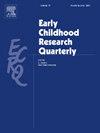Utilizing state workforce registries and targeted surveys to investigate workforce wellbeing
IF 3.1
1区 教育学
Q1 EDUCATION & EDUCATIONAL RESEARCH
引用次数: 0
Abstract
The twofold aim of the presented work was to detail a partnership with the first and third authors, the National Workforce Registry Alliance (NWRA), and two state ECE professional registries and to demonstrate the viability of state workforce registry data and the utility of combining survey data and registry data to investigate predictors of professional and personal workforce wellbeing. Administrative data from state workforce registries was linked to survey data collected by the NWRA (n = 902 respondents). Respondents represented different settings (center-based and family child care home) and roles (teachers and administrators). The Early Childhood Professional Wellbeing Framework (Gallagher & Roberts, 2022) was used to develop a path analysis to demonstrate the effectiveness of the partnership and test the relationships between individual and contextual elements of the framework and latent variables representing professional and personal wellbeing. No individual and contextual elements significantly predicted personal wellbeing, however being part of a historically marginalized population, working in family child care homes, and having more years of experience all significantly predicted professional wellbeing. Professional wellbeing also significantly, positively predicted personal wellbeing (β = 0.95, p < 0.001). The full set of individual and contextual elements and professional wellbeing accounted for 88% of the variance in personal wellbeing (R2 = 0.88, p < 0.001). The utility of workforce registry data, aspects of the partnership, and the benefits and challenges of the process are discussed.
利用国家劳动力登记和有针对性的调查来调查劳动力福利
所提出的工作的双重目标是详细介绍与第一和第三作者,国家劳动力登记联盟(NWRA)和两个国家欧洲经委会专业登记处的合作关系,并展示国家劳动力登记数据的可行性以及将调查数据和登记数据相结合的效用,以调查专业和个人劳动力福利的预测因素。来自州劳动力登记处的行政数据与NWRA收集的调查数据相关联(n = 902名受访者)。受访者代表了不同的环境(中心和家庭托儿所)和角色(教师和管理人员)。儿童早期职业幸福框架(Gallagher & Roberts, 2022)被用于开发路径分析,以证明伙伴关系的有效性,并测试框架的个人和上下文元素与代表专业和个人幸福的潜在变量之间的关系。没有个人和环境因素能显著预测个人幸福感,然而,作为历史上边缘化人群的一部分,在家庭托儿所工作,以及拥有更多年的经验,都能显著预测职业幸福感。职业幸福感也显著正向预测个人幸福感(β = 0.95, p < 0.001)。完整的个人和环境因素以及职业幸福感占个人幸福感方差的88% (R2 = 0.88, p < 0.001)。讨论了劳动力注册中心数据的效用、伙伴关系的各个方面以及流程的好处和挑战。
本文章由计算机程序翻译,如有差异,请以英文原文为准。
求助全文
约1分钟内获得全文
求助全文
来源期刊

Early Childhood Research Quarterly
Multiple-
CiteScore
7.00
自引率
8.10%
发文量
109
期刊介绍:
For over twenty years, Early Childhood Research Quarterly (ECRQ) has influenced the field of early childhood education and development through the publication of empirical research that meets the highest standards of scholarly and practical significance. ECRQ publishes predominantly empirical research (quantitative or qualitative methods) on issues of interest to early childhood development, theory, and educational practice (Birth through 8 years of age). The journal also occasionally publishes practitioner and/or policy perspectives, book reviews, and significant reviews of research. As an applied journal, we are interested in work that has social, policy, and educational relevance and implications and work that strengthens links between research and practice.
 求助内容:
求助内容: 应助结果提醒方式:
应助结果提醒方式:


